Introduction
Adequate nutrition is important for growth and development in children. In general, children are fussy eaters. They prefer and consume more of convenient foods which are mostly processed and ready to eat. The products prepared commercially are tasty but lack almost all important nutrients, thus meeting their daily nutritional requirements becomes difficult. The scenario is worse in the case of children with renal disease as the food intake is reduced due to various reasons like toxic accumulation, metabolic alterations and food restrictions. Taste abnormalities due to toxic accumulation are more common in children with renal disease which affects their food intake in turn resulting in malnutrition.10 Chronic Kidney Disease (CKD) being an increasing and alarming global disease, medical nutritional therapy can be used to prevent the progression of disease and prevent the side effects of the drugs. An approach is necessary to identify and treat these feeding problems which can improve their oral intake, weight gain, and linear growth, which will minimize stressful feeding experiences for parents.11 As the quantity of food intake is reduced in children with renal disease the nutrition recommendation should be qualitative and nutrient dense in terms of selection of food choices to bridge the gap.
Millets were the major staple food in many rural villages in our country.4 Due to modernization and westernization usage of millets became extinct, which gave rise to many diseases. Organic farming and usage of millets are in boom again in our country which is evidenced by slow and steady increase by consumers interest towards procurement. Millets can be called as nutrient package which is rich in protein, fibre, iron, calcium, vitamins and minerals.3 It also exhibits few desirable qualities like antioxidant and phyto chemical properties which helps in fewer digestive complaints, better blood sugar control, lower blood cholesterol levels and reduced rates of cancer especially colon, heart and kidney diseases.9 Studies have clearly stated the evidence of the mechanism behind blood sugar control by millets, due to its bulkiness of fibre content, delayed transition time, thus preventing intake excess calories.13
Shelf life of food is as important as nutrient composition. Good shelf life is an important point in consumer’s acceptability. Shelf life is determined by various factors mainly like chemical composition, Packaging, environmental factors and usage or handling and discussing analysis on shelf life of food helps in better understanding on storage qualities which is an added value7,8
It is well documented and also a well known fact that most of the ingredients in these commercial cookies are tasty but lack almost all important nutrients like refined flour lacking in dietary fiber and micronutrients which are important for health promoting components and hydrogenated fat consists of trans-fats which are proven to be harmful to human health. Recognizing the negative health effects of trans fats many countries have banned the trans-fats in foods and have recommended zero tolerance to trans-fats in foods for infants and other vulnerable groups.
In the present study attempts have been made to improve the nutritional quality of baked product (Cookie) thus by making it a healthy snack option for children with Chronic Kidney Disease. Millets were chosen as a major ingredient considering the protein contribution to the snack and other indigenous ingredients, with utmost importance given to its protein quality in addition to its sodium, potassium and phosphorous.
Materials and Methods
As the primary objective of the study was to develop a suitable nutrient enriched snack – “NUTRI COOKIE- MEP3S” (M- Millet, rich in E- Energy, P- Protein and low in P- Phosphorus, P-Potassium and S- Sodium) for children with renal disorders. The product to be developed was subjected to in depth nutrient analysis of the commonly used cereals and pulses from the nutrient data base (Nutritive value of India Foods, NIN 2012). The aim was to identify the ingredients which are rich in protein and yet limited in its content for sodium, potassium and phosphorus, to suit the dietary restrictions of the children with renal disorder. Based on their nutritional profile, specific millets such as – Setaria italica (Italian millet or Thinai), Panicum miliaceum (Proso millet or Panivaragu), Panicum miliare (Little millet or Samai) were chosen. The selected ingredients were procured from the same vendor for all the trials of standardization to avoid variations. All the millets were dry roasted and ground into fine powder using a standard procedure. Four variants were prepared using the selected ingredients. In all the four variants (A,B,C,D), all the millets were included in equal proportions i.e., 30 grams of each along with 20 grams of roasted Bengal gram flour, which was not included in Sample D alone. Water to bind the flour was used at the rate of 25 ml in the variants A, B, and D while 30 ml was used for the variant C. For sweetening purposes, sugar was used in variant A while palm sugar was used for the other variants. Fifty grams of butter was included in the variants C and D, whereas oil was used in variants A and B. Butter is a leavening agent and a best emulsifier, hence it was used to enhance the texture, flavor and taste of the product for better acceptability. No synthetic food colour and preservatives was added.
Table 1: Composition of Ingredients in Trial I of Samples A, B, C and D.
| Ingredients | Sample A | Sample B | Sample C | Sample D |
| Samai Flour | 30 g | 30 g | 30 g | 30 g |
| Thinai Flour | 30 g | 30 g | 30 g | 30 g |
| Panivaragu Flour | 30 g | 30 g | 30 g | 30 g |
| Bengal gram Flour | 20 g | 20 g | 20 g | – |
| Sugar | 40 g | – | – | – |
| Palm Sugar | – | 40 g | 40 g | 40 g |
| Butter | – | – | 50 g | 50 g |
| Oil | 45 ml | 45 ml | – | – |
| Water | 25 ml | 25 ml | 30 ml | 25 ml |
All the four variants were subjected to organoleptic evaluation using Table 1 illustrates the composition of ingredients used in Trial I of the samples. The first attempt was made to check the feasibility of the product with Four different combinations with minor variation in the ingredients used. All the samples A, B, C and D had millets as the main ingredient, whereas Bengal gram flour, sugar, oil in sample A, Bengal gram flour, palm sugar, oil in sample B, Bengal gram flour, palm sugar, Butter in Sample C and Palm sugar, Butter in Sample D were added in addition to the main ingredient respectively.
Table 2: Composition of Ingredients in Trial II of Samples A & C.
| Ingredients | Sample A | Sample C |
| Samai Flour | 30 g | 30 g |
| Thinai Flour | 30 g | 30 g |
| Panivaragu Flour | 30 g | 30 g |
| Bengal gram Flour | 20 g | 20 g |
| Palm Sugar | 40 g | 40 g |
| Butter | – | 60 ml |
| Oil | 60 ml | – |
| Cardamom | 7 g | 7 g |
| Water | 20 ml | 20 ml |
Table 2 illustrates the composition of ingredients in Trial II. Based on the scores of organoleptic evaluation of Trial I samples scored maximum were taken and suggestions was incorporated in Trial II Variants A and C.
Organoleptic Evaluation
The Cookies prepared from each of the variant was subjected to Organoleptic evaluation using a 9 point hedonic scale, a standard scale for sensory evaluation.2 The scale rating points for adults was described from dislike extremely to like extremely, whereas scale rating for children were described in the forms of smiley. Organoleptic evaluation was carried among both adults and children. The adult panelists comprised of semi trained nutrition professionals, and normal healthy adults from the community. Normal healthy school children were chosen with consent, from schools as the panelists to evaluate the product as the final product was meant for the children as the target group. The variant which received the highest response were subjected to nutrient evaluation for specific nutrients such as Energy, Protein, Carbohydrate, Fat, Sodium, Potassium, Calcium and Phosphorus using AOAC procedures (19th edition 2012/ 920.87 & 999.10) in a NABL accredited laboratory (Kings Institute of Preventive Medicine and Research, Guindy, Chennai). They were also evaluated for their microbial and shelf life analysis. Since the product was meant to be supplemented for children with renal disease who are generally more prone for infections and allergies
Microbial and Shelflife Analysis
Microbial analysis was also performed in the NABL accredited lab using a standard technique and the Total viable count which was observed on 15th day showed no growth of Escherichia Coli and Salmonella SPS and 120 CFU/g and 1 CFU/g of Total Bacterial Count and Yeast/Mould growth respectively in the sample proving that the product complies to standards prescribed for Biscuit under Reg. 2.4.15.(1) of FSS (Food Products Standards & Food Additives) Reg.2011 of FSS Act 2006 is allergen free. This is an indication that the cookies were prepared under good hygienic condition and the integrity of the packaging material used was not compromised.
Shelf life was assessed by storing the product in an airtight plastic container kept at room temperature for observation and assessed for taste, appearance, colour and texture of the product on 0th, 15th, 30th, 45th, 60th, 75th & 90th day, at the end of three months change in colour, appearance, texture and taste was observed. Hence it was found to have a maximum shelf life of three months without any mould growth and taste changes.
Statistical Analysis
The collected data was analysed with IBM.SPSS statistics software 23.0 Version. Descriptive statistics were used for the continuous variables and to find the significant difference between the bivariate samples in Independent groups, ‘t’-test was used. For the multivariate analysis the one way ANOVA with Tukey’s Post-Hoc test was used. In all the above statistical tools the probability value 0.05 is considered as significant level.
Results and Discussion
The developed product was subjected to various Trials (I & II) in an attempt to standardize the final product to be supplemented. The samples were subjected to organoleptic evaluation by a set of three panel members to identify the acceptance of the final product.
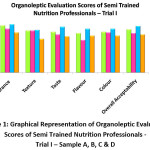 |
Figure 1: Graphical Representation of Organoleptic Evaluation Scores of Semi Trained Nutrition Professionals – Trial I – Sample A, B, C & D Click here to View figure |
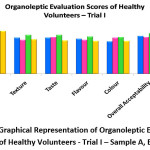 |
Figure 2: Graphical Representation of Organoleptic Evaluation Scores of Healthy Volunteers – Trial I – Sample A, B, C & D Click here to View figure |
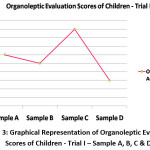 |
Figure 3: Graphical Representation of Organoleptic Evaluation Scores of Children – Trial I – Sample A, B, C & D Click here to View figure |
Of the four variants, Sample A with millet flour, bengal gram flour, palm sugar and oil and Sample C with millet flour, Bengal gram flour, palm sugar and butter received maximum scores by all the panelists in their organoleptic evaluation. Therefore, these two variants (Sample A & C) were chosen and again subjected to the acceptability test using the 9 point hedonic scale of the four.
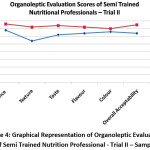 |
Figure 4: Graphical Representation of Organoleptic Evaluation Scores of Semi Trained Nutrition Professional – Trial II – Sample A & C Click here to View figure |
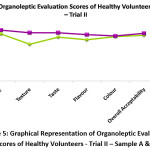 |
Figure 5: Graphical Representation of Organoleptic Evaluation Scores of Healthy Volunteers – Trial II – Sample A & C Click here to View figure |
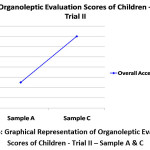 |
Figure 6: Graphical Representation of Organoleptic Evaluation Scores of Children – Trial II – Sample A & C Click here to View figure |
Among the samples A and C, the sample C, with the millets, roasted Bengal gram flour and butter obtained a high overall acceptability score. The above graphical representation of organoleptic scores of trial II indicates that Sample C rated high with maximum scoring among all the three set of panel members.
Nutrient Analysis
The food item when subjected to cooking is proven to have variations in the nutrient content. Hence the finalized product was subjected to nutrient analysis using AOAC guidelines (19th edition 2012). The nutrient phosphorus alone was evaluated in the Food Science lab of Sri Ramachandra Medical College and Research Institute using AOAC Procedure.
Table 3: Proximate Composition of the Product.
| S.No | Nutrients | Values (Per 100g) (Cooked Values ) | RDA |
| 1 | Moisture (%) | 3.7 | – |
| 2 | Ash (%) | 1.2 | – |
| 3 | Energy (kcal) | 450 ± 1.02 | 2082 |
| 4 | Protein (g) | 8.1 ± 0.15 | 39.27 |
| 5 | Carbohydrate (g) | 83 ± 0.15 | 338.2 |
| 6 | Fat (g) | 7.06 ± 0.03 | 63 |
| 7 | Sodium (mg) | 0.284 ± 0.02 | 2000-3000 |
| 8 | Potassium (mg) | 0.219 ± 0.01 | 2000-3000 |
| 9 | Calcium (mg) | 0.034 ± 0.00 | 800-1000 |
| 10 | Phosphorus (mg) | 107.7 ± 0.6 | 800-1000 |
The nutrient analysis revealed that the developed product is low in sodium, potassium, and phosphorus meeting less than 100 (sodium & potassium) and 12 percentage of RDA respectively for children and meeting 21.6 and 20.6percentage of energy and protein requirements respectively. As the target group are subjects with renal disease, the ingredients selected were considered based on low sodium, potassium and phosphorus content.14,15 Hence the developed supplement meets 0.297mg, 0.218mg and 108mg of sodium, potassium and phosphorus requirements of the children respectively.
A study12 compared the quality characteristics of a cookie (snack) which was prepared from combination of millets a nutrient dense package and significantly had positive protein content ranging from 8.30% to 10.9% similar to the cookie developed.
Conclusion
The current study proved that the staple foods are nutrient dense, balanced and could also be tasty by combining various ingredients i.e. Cereal (Millets) and pulses. Appropriate permutations and combinations of the staple Cereals pulses and other commonly used ingredients can be developed into a suitable supplement to suit the palate of children, who are expected to be on dietary restrictions due to their underlying disease condition. The cookie developed in this study, did obtain a high acceptability score not only from adults but from the child panelists as well while yet being low in its content of sodium, potassium and phosphorus, but a good source of calories and protein. This nutri cookie also confers with the need for fluid restriction that is commonly recommended to subjects with renal disease and also proved to be free of microbial contamination compiling to the standards of FSS with a reasonably long shelf life under normal environmental conditions (room temperature). Therefore, the “nutri cookie” can be incorporated as a healthy snack in the diet of healthy and especially in children with renal disorders which would help in improving their nutrient intake and nutritional status.
Acknowledgements
I would like to thank all the panelists for their participation and valuable review.
Funding
The author(s) received no financial support for the research, authorship, and/or publication of this article.
Conflict of Interest
The authors do not have any conflict of interest.
Reference
- Gopalan C, Ramasastri B.V, Balasubramanian SC. Nutritive value of Indian foods. National Institute of Nutrition. 2nd 2012
- J. Hedonic scaling: A review of methods and theory. Food Quality and Preference, 22 : 733–747; 2011.
- Lovis LJ., Alternatives to wheat flour in baked goods., Cereal Foods World,48:61-63; 2003.
- Majumder T.K., K.S.Premavalli and A.S.Bawa., Effect of puffing on calcium and iron contents of ragi varieties and their utilization., Journal of Food Science Technology, 42(5):542-545; 2006.
- Nishizawa N and Fudamoto Y, The elevation of plasma concentration of high density lipo protein cholesterol in mice fed with protein from proso millet., Biosci.Biotechnol.Biochem, 59,333-335;1995.
- Nishizawa N., Oikawa M and Hareyama S., Effect of dietary protein from proso millet on the plasma cholesterol metabolism in rats., Agric.Biol.Chem.,54,229-230;1990.
- Singh, R., Singh, G. and Chauhan, G. S.,Development of soy-fortified biscuits and shelf life studies. Food Sci. Technol., 37 (3): 300-303; 2000a.
- Singh, R., Singh, G. and Chauhan, G. S.,Nutritional evaluation of soy fortified biscuits, Food Sci. Technol., 37 (2): 162-164.,2000b.
- , Facts of fibre. Social Networks and Archival Context, The Regents of the University of California., 2005,pp:1-4.
- McMahon EJ, Campbell KL, Bauer JD. Taste perception in kidney disease and relationship to dietary sodium intake, 2014 Dec;83:236-41. doi: 10.1016/j.appet.2014.08.036. Epub 2014 Sep 2
- Sharon Samaan and Donna Secker., Oral Feeding Challenges in Infants With Chronic Kidney Disease Assessment and Intervention., ICAN: Infant, Child, & Adolescent Nutrition, June 2014.
- Dayanand Peter et al., Quality characteristics of cookies prepared from oats and finger millet based composite flour, Engineering Science and Technology: An International Journal, August 2013, ISSN: 2250-3498.
- Kanga et al, Diversifying food and diets,1st Edition, 2013.
- Krikken Jan A, Laverman Gozewijn D, Navis Gerjan., Benefits of dietary sodium restriction in the management of chronic kidney disease, Current Opinion in Nephrology and Hypertension: Volume 18 – Issue 6 – p 531–538, 2009.
- KDOQI Clinical Practice Guideline for Nutrition in Children with CKD: 2008 Update

This work is licensed under a Creative Commons Attribution 4.0 International License.






